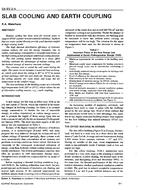Description
Radiant cooling has been used for several years to support HVAC systems in nonresidential buildings. Surfaces that are water cooled directly provide good thermal comfort at high cooling loads. The high thermal distribution efficiency of hydronic systems reduces the cost for energy transport, but, in reality, total energy consumption is insignificantly lower, as the high cooling power produces additional cooling demand. The slab cooling system installed in a Swiss office building combines the advantages of radiant cooling with the thermal storage of massive concrete ceilings. The concrete core is cooled by cold water during the night. The water circuit includes a water/air heat exchanger, which cools down the ceiling to 20 deg to 22 deg C by means of heat exchange with the cool night air. During the day, the ceiling absorbs the room loads and keeps the air temperature in the comfort range. The heat exchange in the building occurs at a relatively high temperature level (20 deg to 26 deg C), which allows the use of alternative cooling sources, e.g., earth coupling.
KEYWORDS: cooling, indoor air, offices, cooling load, energy storage, ceilings, concrete heat storage, air water heat exchangers, Switzerland, radiant cooling, nighttime cooling, Austria, art galleries, models, structure heat storage, case studies, ceiling cooling.
Citation: Symposium, ASHRAE Trans., 1993, vol.99, part 2, paper number DE-93-1-1, 429-439, 7 figs, 2 tabs, refs.
Product Details
- Published:
- 1993
- File Size:
- 1 file , 1.2 MB
- Product Code(s):
- D-17451




